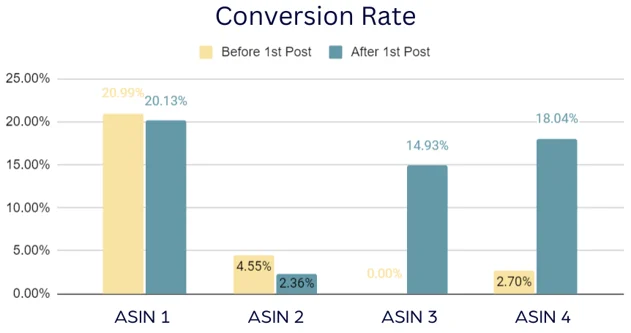Tamara Vukovic is a Senior Account Specialist at Acadia
Again and again, I have found that brands are overlooking one of Amazon’s simplest tools to grow their visibility: Amazon Posts.
You can think of Amazon Posts as the e-commerce giant’s version of Instagram. You upload photos of your products alongside a caption and category tags. As on Instagram, if customers like your content, they can follow your brand for more.
A post looks a lot like an Instagram grid photo. Each one appears not only on your brand’s digital storefront, but also on product detail pages, category-based feeds, and “related product” feeds.

Source: JUST Water Post example on Amazon.com
In each post, you can tag up to ten ASINs, which means that you can cross-promote multiple of your products at once. In other words, a good post can draw in a big audience—especially if you are in a product category that shoppers browse often.
I have analyzed data from 5 brands and 190 posts, and from my experience, the evidence is clear. For the brands that take advantage of it, Amazon Posts can drive an impressive spike in conversion rates. Best of all, Amazon Posts are totally free.

Source: Pharmacopia Post example on Amazon.com
How should you perfect your Amazon Posts strategy?
Use Posts to “defend” your product detail page and “attack” competitors’ PDPs. Your posts can show up on the PDPs for your own products—and they can also show up on the PDPs of your competitors. That creates a two-pronged opportunity for brands.
If your competitors are actively using Posts, you should create your own content to “defend” your PDP. In other words, you ensure that your posts, not your competitor’s, will show on your PDP.

Source: Amazon.com
At the same time, if you notice that your competitors are checked out of Amazon Posts, you can press your advantage. By tagging related hashtags, you can get your post to surface up on the PDPs of rival products. That helps customers discover your brand even when they’re clicking on competitor PDPs.
You don’t have to reinvent the wheel with your posts. Right now, most of my clients that use Amazon Posts simply repurpose their content from Instagram. This works well. You don’t have to create unique content for Amazon.
If you’re unsure what photos to choose, I recommend choosing simple, high-quality images that can tell a story on their own. Amazon Posts can also be a great way to get more out of content partnerships you might have with influencers. Pick an Instagram post that shows an influencer interacting with your product, and you’re good to go.
Take advantage of captions. Amazon currently lets brands pair their photos with up to 2,200 characters of text. The first two lines of text are displayed by default under each image. You can use this space to tell shoppers something new about your brand. You might include a customer testimonial, for instance, or address a FAQ.
I have found that the best-performing posts emphasize the benefits of the featured product, its key ingredients, and more. Be sure to brag: If your product is brand sustainable, eco-friendly, or cruelty-free, you should mention it in your caption.

Source: Amazon.com
Be smart about how many products you tag. Amazon lets you tag up to 10 products per post, but I’ve found that the ideal number of products to tag in your post is 3 to 8.
Here’s an example, from one of many tests we’ve run with clients:

Focus on seasonal events. Certain shopping events, like the holiday season, the start of the school year, and so on, might bring an influx of attention to your products. If you’re preparing for a big event or a season start, Amazon Posts are a great way to get your brand noticed.
In August, there are already going to be a lot of eyeballs on, say, the school supplies category on Amazon, so pushing out posts featuring your product is an easy and free way to help you stand out.
You can also combine posts with a planned ad campaign. By tagging an ASIN that you are putting a lot of marketing money behind, you can increase impressions and engagements on each post.
To see what I mean, here’s how the metrics for one post from a beauty client shifted during the high-traffic week of Christmas:

Building up your following is nothing to turn your nose at. Amazon Posts ultimately drive traffic back to your brand store, where customers can click to “follow” your account to see future updates from you. Because Amazon is not exactly a social platform, some people are skeptical of the value of building a following on the platform. But it can make a big difference.
When a customer follows you on Amazon, for instance, they receive notifications whenever you have a discount or a deal. Those deals also appear on the homepage of anyone who follows your brand. With the Brand Follow tool, you can push out these deals to your customers without having to spend money on an ad.
The bottom line: Amazon Posts are low risk. They are free to post. At most, the only sunk cost is a couple of hours every week reformatting your images and checking your metrics.
Why do some posts get promoted over others?
Posts do give you valuable metrics about how each post performs. You can uncover follow clicks, product clicks, viewable impressions, engagement rates, and the overall reach of your content.
But there’s a lot we still don’t know about how Amazon Posts work. Some posts will surface widely on product detail pages, while others do not. Oddly, how widely a given post gets disseminated doesn’t seem to correspond to engagement rates.
Because the success of a post can sometimes be a shot in the dark, I always advise clients to add new content 2-3 times a week.
By posting regularly, you increase the chances that your content shows up on category feeds and on the PDPs of rival brands. If you only post, say, once a month, you risk losing your visibility.
Do Amazon Posts really boost conversion rates?
The answer is a resounding yes. As you can see below, one post doesn’t always move the needle. But when a post does take off, it can do a lot to drive sales conversions.

Posts can be an effective way to grow brand awareness on Amazon, but there is a learning curve and best practices tend to shift over time. At Acadia, we help brands to set up and manage their Posts strategy within an overall channel marketing program.


